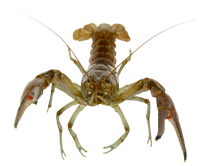Behavioral Neuroscience, lecture on Crayfish and its behavior
Escape - Crayfish
V. Sensory stimulaton of Crayfish Escape
A. Rapid flips of the Crayfish tail excited by strong, sudden sensory stimuli
1. Sensory input can be to any or all of 3 neural circuits
a. redundancy is an important evolutionary adaptation in neural systems
i. escape from predators is an absolutely necessary function
2. 3 bilateral pairs of "command" neurons
a. Medial Giant (MG)
b. Lateral Giant (LG)
c. non-giant (NG)
B. Sensory neurons for escape are activated by tactile stimuli
1. Activated by touch, pressure or pain to 4 main regions
a. Rostrum and Head
i. Complex and multimodal
ii. head includes sight*, smell#, taste#, touch, pressure, pain
1) *eyestalks
2) #antennae
iii. tactile via cuticular sensory hairs
iv. both tactile mechanosensory and visual stimuli activate MG neurons
b. Carapace
i. tactile cuticular sensory hairs
1) effective even here
c. Abdomen
i. tactile mechanosensory neurons activate LG neurons
1) activates multi-segmental LG connective
broadens effect
ii. but also results in coincidence detection
1) ie. 2 signals at once
d. Tail Fan
i. tactile cuticular sensory hairs
1) easy to see here
2. Tactile mechanosensory neruons typically come in 3 types:
a. T/P/N - Touch, Pressure and Pain (Nociceptive) cells
b. All have similar morphological features
i. sensory stretch receptors
1) often modified to enhance detection
a) in crayfish with cuticular hairs
ii. receptors connected to long dendrites
1) similar to axons, but afferent to the soma
iii. Single process arises from cell body
1) large 1o branches pass through neuropil
a) leave the ganglion in peripheral nerve roots
2) 2o processes different among T/P/N
c. have dissimilar action potential thresholds
i. T fire very easily
1) resting potential close to threshold potential
ii. P require more stimulation to fire
iii. N are very difficult to fire
d. Crayfish have mechanoreceptive sensory neurons
i. with a strong stimulus all mechanoreceptors fire simultaneously
1) across extended regions of the body
2) weaker stimuli don't activate simultaneous firing
ii. Are they T/P/N?
e. Crayfish sensory neurons secrete Acetylcholine (ACh)
i. most T/P/N neurons are gluatmatergic (Glu)
f. Crayfish sensory neurons innervate sensory interneurons (SI)
i. Sensory ACh binds Nicotinic receptors on sensory interneurons
ii. sensory interneurons (SI) innervate MG, LG, and NG neurons
1) MG and LG neurons inhibit sensory ACh synapses
a) presynaptically
2) MG and LG neurons inhibit interneuron Nicotinic synapses
b) postsynaptically
C. Sensory input to MG neurons
1. MG are 2 large neurons in the brain and thorax ganglia
2. Activated by strong rostral stimuli
a. received from head and thorax
3. passed through sensory interneurons to MG
a. via electrical synapses
D. Sensory input to LG neurons
l. LG are 2 large neurons found in abdominal ganglia
a. including ganglion 13 to the tail
2. Tail and abdomen Sensory excitatory afferents
a. mechanosensory/displacement receptors
i. excited by strong, sudden physical stimulus to tail
1) or abdomen
3. receive excitatory inputs from descending sensory interneurons
originating in the brain
a. activated by stimulation of the antenna II nerve
b. protocerebral tract
c. descending inputs alone can not cause action potentials in the LGs
d. paired with stimulation of tail afferents: inputs sum to yield firing
e. LG escape neurons integrate sensory information
i. received through both rostral and caudal receptive fields
1) excitatory inputs that are activated rostrally can
bring the LGs' membrane potential closer to threshold
E. Sensory input to NG neurons
1. non-Giant neurons (NG) receive sensory information
from all interneurons
2. Rostral (head and thorax) sensory information
plus
3. Caudal (abdomen and tail) sensory information
F. Sensory information is delivered rapidly and disseminated broadly
